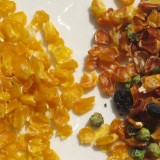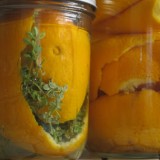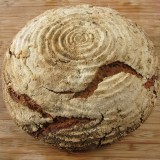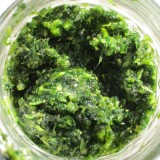For my final project in the Los Angeles Master Food Preserver Program I attempted to see how many ways I could preserve the abundant pads of the prickly pear cactus that grows in our front yard. Of course they are best fresh, but I like them so much that I wanted to see if I could preserve some for use later in the year. Incidentally, I prepare them fresh by first cutting them into strips and boiling them for five minutes to remove the mucilaginous texture. After boiling I pan fry them and serve them with eggs. It’s a meal that comes, except for the salt, entirely out of the yard. What follows are the methods I used to preserve those tasty pads.
Dehydrated
I removed the spines, cut the pads into 3/4 inch strips and boiled them for one minute. I then marinated them for ten minutes in soy sauce and dried them until brittle in an Excalibur dehydrator at 135º F for a couple of hours. Prepared this way they actually taste a bit like beef jerky. You definitely need to spice them–when dried plain they have a bit of a dirt note in terms of taste. Next year I plan on trying some more dried “nopalitos” with some different marinades.
Frozen
Once again, I removed the spines. cut them into strips and boiled them for one minute. I then packed them in to freezer bags. Freezing is the best method in terms of taste and nutrition. It’s easy and it works great.
Pickled
I used the this okra recipe from the National Center for Home Preservation for my pickled nopalitos. They turned out very tasty.
Pressure Canned
Prickly pear is sold canned both in water and with a small amount of vinegar. Unfortunately there are no tested home canning recipes for pressure canned prickly pear pads (this needs to be rectified but is difficult in an era of reduced funding for Extension Services). I used a tested recipe for okra and consumed the product immediately as I don’t trust my own untested pressure canning recipes. The results were acceptable but not exciting–basically they tasted like canned vegetables and had a slightly mushy texture. If I had a tested recipe to work with, that used a small amount of vinegar, perhaps the processing time could be reduced, leading to a crisper result.
Lastly I should mention that I’ve dried and made jelly with the fruit in previous years. If you’ve got a favorite way to preserve the pads or fruit please leave a comment.







How do you remove the spines? The only method I have is by accidentally touching cactus and having spines in my fingers for weeks.
Are they really blue when dehydrated?
Frozen–do you have to blanch them?
Can you eat all varities?
Alabama is not cactus country, so I don’t know why I want to know.
The blue is my not so good photography–they are green. Yes–frozen you need to blanch, which is the case for most vegetables. Opuntia cactus comes in many different varieties, and I’m not sure if all are edible. Some are definitely better than others. The plant is highly adaptable and I suspect might even grown in Alabama.
None of the Opuntia are poisonous, but some do taste better than others.
I really appreciate this post — I just planted a prickly pear and I never considered how to preserve the pads. Of course, mine is still a baby, but like all babies this one will certainly grow, and I better be ready!
You mentioned boiling and freezing, so I wondered if they needed the immediate cooling like other vegetables.
Sorry to point out the blue. Some days it seems the color is hard to capture and I post funky colors.
I appreciate the reminder–need to watch my color balance especially when photographing food!
We have prickly pears all over our neighborhood, and I have the same question. How do you make any use of them without getting prickers lodged in your skin (and/or mouth) for weeks? I hear of people using them, but I can’t even manage to pick them without getting grumpy!
With the skillful use of a knife. It’s pretty easy, actually. You drag the knife at a 90 degree angle across the pad and all the sines pop off. The fruit, on the other hand, is more difficult. Luther Burbank also developed spineless varieties that you can find with a little googling.
If you pick the nopales/pads, you want to pick them when they are smaller than your hand (I think 2″ is best) and at that time the stickers are rubbery and you can just “knock” them off with a knife. If they get much larger than that they are so fiberous, you can’t cut them with a sharp knife.
The ones you find in grocery stores are grown commercially and are watered and fertilized on a regular basis.
For any future visitors – the easiest way to get the spines off the fruit (prickly pears) is to burn them off. A pair of tongs and a gas stove do the trick!
To clean prickly pears without getting prickles, pick them with salad or braai (BBQ tongs). Drop them on the ground. When you have enough on the ground, use your tongs to roll them on the ground once or twice then put them in a container/bucket. Got to your garden hose, empty your bucket onto the lawn, use the sprayer to spray the pears and roll them while you do that. They should be pretty spine free by now. Use your tongs to return them to the bucket.
To peel them without touching them, use a knife and fork. Pierce the skin in the middle of the pear (lengthways) with your fork. With a nice sharp knife, top and tail the pear then slice the skin open in front of your fork (which is used to hold it down). Roll the fruit out of the skin and pop it into a second, clean container. You’ll have no spines and wont ever have to touch the fruit until you eat it.
i’m pretty sure you can dry them, grind them, and then use part of them mixed with corn flour to make corn/nopal tortillas.
Thanks for that suggestion. I’ve also seen dried and powdered nopal sold as a kind of vitamin supplement.
Longtime fan, and I’m not sure if I’ve hit you up before. I’m the founder/moderator for Punk Domestics (www.punkdomestics.com), a community site for those of use obsessed with, er, interested in DIY food. It’s sort of like Tastespotting, but specific to the niche. I’d love for you to submit this to the site. Good stuff!
My friend, Josefina, who is originally from Michoacan, recommends putting guava leaves in with the cooking liquid. She says they help remove the slimy texture.
Thanks for the tip!
For diabetics, cactus is fabulous for blood sugar stabilization. I juice a small pad every few days to add to my smoothie. It’s a slimy mess, but I’m willing to overcome that for it’s benefits.
Candied! I like using a vinegar green bean recipe for water bath canning, but I also like cooking the heck out of them in sugar reduced to a syrup with lemon, sometimes orange juice, salt, and chile. I usually dry this on a baking cooling rack in the sun, or sometimes on wax paper on a cookie sheet. Depending on the weather they take a day or two. Haven’t got botulism yet!
Candied?!? I would love to see the recipe for that!!! It just sounds amazing!
Nopales make great tacos…
http://acommonstreetpeddler.blogspot.com/2012/09/nopales-cactus-tacos.html
This is an awesome site so thank you for all the information on prickly pears. Will definitely book mark it and return often.
We’ve done all sorts of things with nopales cactus in texas.
Used them with marinaded onions in vinegar. Brandyied candied cactus ,dried,pickles ,using them to make jerky never thought of that. They do make great addition with corn for tortillas etc. I have a recipe you can try we been using about 20 years I got from a fellow down in Laredo tx.
I spice em up though adding red pepper flakes or garlic and also jalapeño. They stay crispy if you barely Blanche them at all but they wil get cooked some in the canning process anyway. My wife is the one who cooks cans them if you’ll email me i will have her send you the recipe as she’s asleep now I’m afraid to ask. I do know they’re like vlasic pickles when she gets done nice and tasty I eat the marinaded ones with onions with about anything. Thanks for the post very nice.
I would be interested in the canning recipe for Nopales Rick Brown. If you wouldn’t mind sharing I’d be very appreciative. You may email to [email protected]
Boil for 20 to 30 min, till you can bite through the skin. You add 3 garlic cloves half an onion sliced and salt and boil till crisp to the bite. Let cool and drain. Place in the refrigerator and serve as needed.my favorite is throw some in the frying pan add egg , when cooked add home made hot sauce and simmer. You can add fresh panela cheese. MMM. Sevved with refried beans and bacon. Enjoy.
using calcium chloride when pickling them, might help them stay crisp. Just a thought.
Pingback: How to Preserve {Pretty Much} Anything: Part 2 - Keeper of the Home